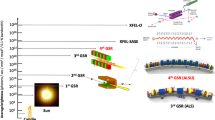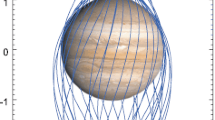Abstract
We describe the construction and characterization of the 280 GHz bolometric focal plane units (FPUs) to be deployed on the second flight of the balloon-borne Spider instrument. These FPUs are vital to Spider’s primary science goal of detecting or placing an upper limit on the amplitude of the primordial gravitational wave signature in the cosmic microwave background (CMB) by constraining the B-mode contamination in the CMB from Galactic dust emission. Each 280 GHz focal plane contains a \(16 \times 16\) grid of corrugated silicon feedhorns coupled to an array of aluminum–manganese transition-edge sensor (TES) bolometers fabricated on 150 mm diameter substrates. In total, the three 280 GHz FPUs contain 1530 polarization-sensitive bolometers (765 spatial pixels) optimized for the low loading environment in flight and read out by time-division SQUID multiplexing. In this paper, we describe the mechanical, thermal, and magnetic shielding architecture of the focal planes and present cryogenic measurements which characterize yield and the uniformity of several bolometer parameters. The assembled FPUs have high yields, with one array as high as 95% including defects from wiring and readout. We demonstrate high uniformity in device parameters, finding the median saturation power for each TES array to be \(\sim \)3 pW at 300 mK with a less than 6% variation across each array at \(1\sigma \). These focal planes will be deployed alongside the 95 and 150 GHz telescopes in the Spider-2 instrument, slated to fly from McMurdo Station in Antarctica in December 2018.



Similar content being viewed by others
References
Planck Collaboration, Planck 2015 results. X. Diffuse component separation: Foreground maps. Astron. Astrophys. 594, 63 (2015)
BICEP2 Collaboration, Keck Array Collaboration, Improved constraints on cosmology and foregrounds from BICEP2 and Keck array cosmic microwave background data with inclusion of 95 GHz band. Phys. Rev. Lett. 116, 031302 (2016)
Planck Collaboration, Planck 2015 results. XIII. Cosmological parameters. Astron. Astrophys. 594, A13 (2016). arXiv:1502.01589
B. Crill et al., Spider: a balloon-borne large-scale CMB polarimeter. Proc. SPIE 7010, 70102P (2008)
J. Filippini et al., Spider: a balloon-borne CMB polarimeter for large angular scales. Proc. SPIE 7741, 77411N (2010)
A. Fraisse et al., Spider: probing the early Universe with a suborbital polarimeter. J. Cosmol. Astropart. Phys. 2013(4), 047 (2013)
A. Rahlin et al., Pre-flight integration and characterization of the Spider balloon-borne telescope. Proc. SPIE 9153, 915313 (2014)
J. Gudmundsson, The thermal design, characterization, and performance of the Spider long-duration balloon cryostat. J. Cryog. 72, 65–76 (2015)
M.C. Runyan et al., Design and performance of the Spider instrument. Proc. SPIE 7741, 77411O (2010)
BICEP2, Keck Array, and Spider Collaborations. Antenna-coupled TES Bolometers Used in BICEP2, Keck Array, and Spider. Astrophys. J. 812(2), 176 (2015)
J. Nagy et al., A new limit on CMB circular polarization from Spider. Astrophys. J. 844(2), 151 (2017)
J. Hubmayr et al., Design of 280 GHz feedhorn-coupled TES arrays for the balloon-borne polarimeter Spider. Proc. SPIE 9914, 99140V (2016)
D. ODea et al., Spider optimization II: optical, magnetic and foreground effects. Astrophys. J. 738(1), 63 (2011)
S. Duff et al., Advanced ACTPol multichroic polarimeter array fabrication process for 150 mm wafers. J. Low Temp. Phys. 184(3–4), 634–641 (2016)
J. McMahon et al., Planar Orthomode Transducers for Feedhorn-coupled TES Polarimeters, in AIP Conference Proceedings, vol. 1185, No. 1, pp. 490–493 (2009)
J.W. Henning et al., Optical efficiency of feedhorn-coupled TES polarimeters for next-generation CMB instruments. Proc. SPIE 7741, 774122 (2010)
S.W. Deiker et al., Superconducting transition edge sensor using dilute AlMn alloys. Appl. Phys. Lett. 85(11), 2137 (2004)
G.M. Stiehl et al., Time-division SQUID multiplexers with reduced sensitivity to external magnetic fields. IEEE Trans. Appl. Supercond. 21(3), 298–301 (2011)
P.A.J. de Korte et al., Time-division superconducting quantum interference device multiplexer for transition-edge sensors. Rev. Sci. Instrum. 74, 8 (2003)
BICEP2 Collaboration, BICEP2 II: experiment and three-year data set. Astrophys. J. 792(1), 62 (2014)
Acknowledgements
Spider is supported in the USA by the National Aeronautics and Space Administration under Grant Nos. NNX17AC55G and NNX12AE95G issued through the Science Mission Directorate and by the National Science Foundation through PLR-1043515. Additional support is provided by the Department of Energy Grant DE-SC007859. Corresponding author is supported by a National Science Foundation Graduate Research Fellowship. Logistical support for the Antarctic deployment and operations was provided by the NSF through the U.S. Antarctic Program. Support in Canada is provided by the National Sciences and Engineering Council and the Canadian Space Agency. Support in Norway is provided by the Research Council of Norway. Support in Sweden is provided by the Swedish Research Council through the Oskar Klein Centre (Contract No. 638-2013-8993). We also wish to acknowledge the generous support of the David and Lucile Packard Foundation, which has been crucial to the success of the project. The collaboration is grateful to the British Antarctic Survey, particularly Sam Burrell, for invaluable assistance with data and payload recovery after the 2015 flight.
Author information
Authors and Affiliations
Corresponding author
Rights and permissions
About this article
Cite this article
Bergman, A.S., Ade, P.A.R., Akers, S. et al. 280 GHz Focal Plane Unit Design and Characterization for the Spider-2 Suborbital Polarimeter. J Low Temp Phys 193, 1075–1084 (2018). https://doi.org/10.1007/s10909-018-2065-2
Received:
Accepted:
Published:
Issue Date:
DOI: https://doi.org/10.1007/s10909-018-2065-2




